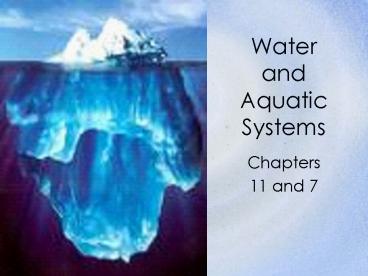Water and Aquatic Systems PowerPoint PPT Presentation
1 / 43
Title: Water and Aquatic Systems
1
Water and Aquatic Systems
- Chapters
- 11 and 7
2
The Water Cycle
Evaporation, Condensation, Precipitation
3
Renewable Resource
- Water is a renewable resource because it is
cycled between the Earths surface and the
atmosphere.
4
The Oceans
- Important because almost all Earths water is in
the oceans. - Global water
- distribution.
Salt water 97
- Fresh water 3
- Ice caps and glaciers 77
- Ground 22
- Other fresh 1
5
Surface Water
- Fresh water on Earths surface.
- Lakes, rivers, streams, wetlands.
- Streams form rivers, rivers form river systems.
6
Watersheds
- Area of land drained by a river.
7
Ground Water
- Fresh water available for human consumption.
- Water stored beneath the Earths surface in
sediment and rock formations.
8
Aquifers
- Underground formation containing ground water.
- Ogallala10-40 more water out than can be
replaced.
9
Recharge Zone
- The area of the Earth where water percolates down
to refill an aquifer.
10
11.2- Water UseandManagement
11
Water Shortages
- Shortage of clean, fresh water is one of the
worlds most pressing environmental problems. - More than 1 billion people lack access to a
clean, reliable source.
12
Major Uses of Water
- Residential
- 10 in North America.
- Agricultural
- 48
- Industrial39
13
Water Treatment
- Potable (safe to drink)- water treatment removes
mercury, arsenic, and lead as well as pathogens
such as bacteria, viruses, protozoa, and
parasitic worms.
14
Industrial Use
- Highest of industrial water usage occurs in N.
America and Europe. - 19 world wide
15
AG Water Use
- 67 of world water use
- Plants need a lot of water
- Large percent of water is evaporated before gets
to roots
16
Water Management
- Projects can have various goals.
- Make dry area habitable.
- Creating a reservoir for recreation or drinking.
- Generating electric power.
17
Conservation
- Conservation will ensure that there is enough
water for all! - AG- drip irrigation
- Indust. reuse cooling waste water
- Home- short showers, dont run water, water lawn
sparingly, only full loads of clothes dishes
18
11.3- Water Pollution
19
Water Pollution
- The introduction chemical, physical, or
biological agents into water that degrade water
quality and adversely affect the organisms that
depend on it.
20
Point-Source Pollution
- Pollution discharged from a single source.
- ie Factory, Leaking oil tanker, or unlined
landfills
21
Non-point Source
- Comes from many different sources which are often
difficult to identify. - A river polluted from many land runoffs.
22
Principle Water Pollutants
- Pathogens
- Organic matter
- Organic chemicals
- Inorganic chemicals
- Heavy metals
- Physical agents
23
Waste Water
- Water that contains waste from home or industry.
- Water that goes down your drain.
24
Sewage Sludge
- The solid waste left after water has been
treated. - Expensive to dispose of.
- Must be disposed of properly.
25
Eutrophication
- Natural or artificial- excess nutrients in a body
of water. - Causes excess plants, depletion of O2, algal
blooms, etc.
26
Eutrophication
27
Thermal Pollution
- Temperature of a body of water increases.
- When power plants use water in their cooling
system and then discharge it in to lakes and
rivers.
28
Ground and Ocean
- Ground- pollutants percolate down
- Long recharge time
- Ocean- Most pollutants from land
- oil from city runoffs
29
Biomagnification
- The amount of pollution stored at each level in a
food chain increases at each successive level.
30
(No Transcript)
31
Aquatic Ecosystems
- Lesson 7.1
32
Fresh Water
- Lakes
- Rivers
- Ponds
- Streams
- Wetland- land that is periodically under water.
33
Marine Ecosystems
- Marshes (fresh or salt)
- Swamps (fresh or salt)
- Coral reefs (salt)
- Oceans (salt)
34
Water Organisms
- Factors that determine which organisms live in
which areas of the water - Temperature, sunlight, oxygen, and nutrients.
35
Aquatic Ecosystems
- Three groups of organisms depending on their
location and adaptations. - Plankton, nekton, and benthos.
36
Plankton
- Organisms that float near the surface of the
water. - Phytoplankton- microscopic plantprovide most of
the food for an aquatic system. - Zooplankton- microscopic animals
37
Nekton
- Free swimming organisms.
- Fish, turtles, and whales
38
Benthos
- Bottom dwelling organisms.
- Mussels, worms, barnacles.
39
Lake Zones
- Littoral zone- upper part of lake where
photosynthesis can occur.Aquatic life is diverse
and abundant. - Benthic Zone- lower part. Inhabited by
decomposers, insect larvae, and clams.
40
Freshwater Wetlands
- Marsh-contain non woody plants such a cattails.
- Swamps- dominated by woody plants such as trees
and shrubs.
41
Human Impact
- Humans once thought of wetlands as wastelands.
- Filled in, drained, and cleared for farms or
residential/commercial use.
42
7.2-
- Marine Ecosystems
43
(No Transcript)

